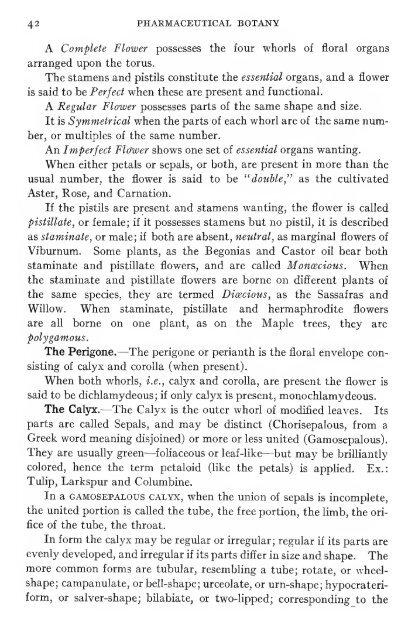Pharmaceutical botany - Lighthouse Survival Blog
Pharmaceutical botany - Lighthouse Survival Blog
Pharmaceutical botany - Lighthouse Survival Blog
You also want an ePaper? Increase the reach of your titles
YUMPU automatically turns print PDFs into web optimized ePapers that Google loves.
42<br />
PHARMACEUTICAL BOTANY<br />
A Complete Flower possesses the four whorls of fioral organs<br />
arranged upon the torus.<br />
The stamens and pistils constitute the essential organs, and a flower<br />
is said to be Perfect when these are present and functional.<br />
A Regular Flower possesses parts of the same shape and size.<br />
It is Symmetrical when the parts of each whorl are of the same num-<br />
ber, or multiples of the same number.<br />
An Imperfect Flo'wer shows one set of essential organs wanting.<br />
When either petals or sepals, or both, are present in more than the<br />
usual number, the flower is said to be "double," as the cultivated<br />
Aster, Rose, and Carnation.<br />
If the pistils are present and stamens wanting, the flower is called<br />
pistillate, or female; if it possesses stamens but no pistil, it is described<br />
as staminate, or male; if both are absent, neutral, as marginal flowers of<br />
Viburnum. Some plants, as the Begonias and Castor oil bear both<br />
staminate and pistillate flowers, and are called Moncecious. When<br />
the staminate and pistillate flowers are borne on different plants of<br />
the same species, they are termed Diwcious, as the Sassafras and<br />
Willow. When staminate, pistillate and hermaphrodite flowers<br />
are all borne on one plant, as on the Maple trees, they are<br />
polygamous.<br />
The Perigone.—The perigone or perianth is the floral envelope con-<br />
sisting of calyx and corolla (when present).<br />
When both whorls, i.e., calyx and corolla, are present the flower is<br />
said to be dichlamydeous; if only calyx is present, monochlamydeous.<br />
The Calyx.—The Calyx is the outer whorl of modified leaves. Its<br />
parts are called Sepals, and may be distinct (Chorisepalous, from a<br />
Greek word meaning disjoined) or more or less united (Gamosepalous).<br />
They are usually green—foliaceous or leaf-like—but may be brilliantly<br />
colored, hence the term petaloid (like the petals) is applied. Ex.:<br />
Tulip, Larkspur and Columbine.<br />
In a GAMOSEPALOUS CALYX, when the union of sepals is incomplete,<br />
the united portion is called the tube, the free portion, the limb, the ori-<br />
fice of the tube, the throat.<br />
In form the calyx may be regular or irregular; regular if its parts are<br />
evenly developed, and irregular if its parts differ in size and shape. The<br />
more common forms are tubular, resembling a tube; rotate, or wheel-<br />
shape; campanulate, or bell-shape; urceolate, or urn-shape; hypocrateri-<br />
form, or salver-shape; bilabiate, or two-lipped; corresponding to the
















